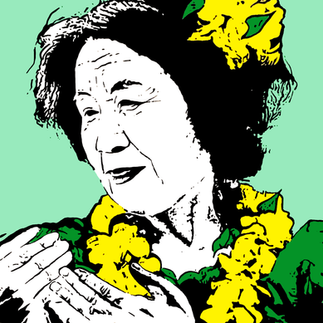What Andy Warhol Did for Pop Culture, I Aim to Do for Religion
What Andy Warhol did for American pop culture, I have been striving to do for religion—particularly the symbols and iconography of Eastern traditions. Warhol redefined how we engage with the mundane by transforming everyday objects into works of art. His vision diluted the grandiosity of American exceptionalism, presenting icons of consumerism like Campbell’s soup cans and Coca-Cola bottles as universal symbols. These weren’t merely commercial items; they became cultural artifacts, accessible to everyone, regardless of class or background. His genius lay in reframing the familiar, creating a bridge between art and popular culture that reshaped global aesthetics.
In a similar vein, my work seeks to reinterpret religious iconography—primarily from Eastern traditions like Taoism, Buddhism, and Hinduism—through a lens that resonates with American culture. I aim to elevate the sacred symbols of these traditions into tactile, visual experiences that Western audiences can engage with and understand. By blending spirituality with the vibrant, accessible style of pop art, I hope to bridge cultural gaps and spark new conversations about faith, interconnectedness, and the universality of the human experience.
Reframing Faith Through Pop Art
Religion often feels distant or untouchable in art, steeped in tradition and ritual that can alienate those outside of its immediate cultural context. My approach is to reimagine these symbols in a way that strips away some of their mystique without diminishing their profundity. For example, by portraying Hindu gods or Buddhist mandalas in bold, commercialized forms, I aim to make them feel both sacred and accessible—bridging the gap between reverence and familiarity.
Pop art has always been about accessibility, taking what is common and giving it new life. In this way, my work echoes Warhol’s ethos: to create art that speaks not only to insiders but to anyone willing to engage with it. However, where Warhol critiqued consumerism and American values, my focus is on global spirituality—connecting audiences to traditions they may never have encountered and inviting them to see the shared humanity within them.
Elevating Spirituality for a Global Audience
The heart of my work lies in elevating global spirituality into a visual language that transcends borders. In today’s world, where cultural exchange happens at the speed of a swipe, art can serve as a powerful bridge between disparate traditions. By transforming the symbols of faith into something visually engaging and rooted in pop culture aesthetics, I want to challenge the perception that spirituality belongs to specific cultures or groups.
This doesn’t mean diluting the meaning of these symbols; rather, it means reframing them so they can resonate with audiences unfamiliar with their original context. For instance, my Made in Taiwan series juxtaposed Eastern religious iconography with commercial pop art to highlight the intersection of consumerism and spirituality. The goal wasn’t to critique but to connect—to show how these traditions can coexist and adapt in a globalized world.
The Personal Connection
My work is deeply personal. While my Catholic upbringing forms the foundation of my spiritual understanding, my travels through Asia have profoundly shaped my view of faith and art. The sacred spaces I’ve encountered, from Taoist temples to Buddhist monasteries, have enriched my perspective and allowed me to see the common morality that binds all faiths. This fusion of personal experience and artistic exploration drives my work, making it both a reflection of my journey and an invitation for others to embark on their own.
Where Pop Art Meets the Sacred
At its core, my work asks a simple question: Can the sacred be made accessible without losing its essence? By drawing on the bold, vibrant tactics of pop art, I believe the answer is yes. Just as Warhol reframed everyday objects into cultural icons, I aim to elevate religious symbols into modern, universal touchpoints. The goal isn’t to reduce these symbols to consumer items but to present them in a way that invites curiosity, dialogue, and perhaps even reverence from a new audience.
Ultimately, my work is about connection—connecting people to art, to faith, and to each other. In a world increasingly defined by division, I believe art has the power to remind us of the shared humanity that lies beneath the surface of all our traditions.
Does this expanded essay capture your vision? Let me know if there are areas you’d like to elaborate on further, or if you’d like examples from your portfolio woven in for depth!











































































































































































































